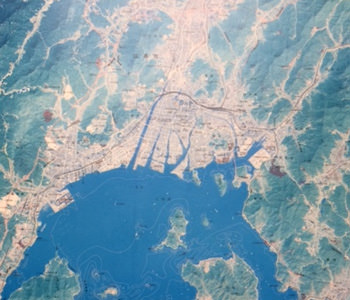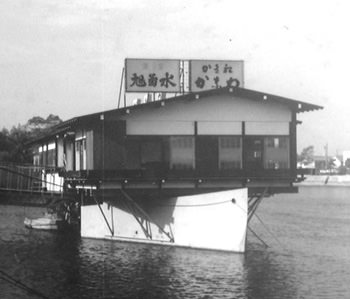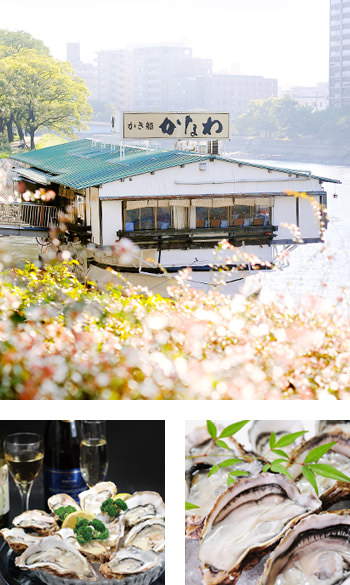かなわの歴史
History
広島牡蠣についてAbout Hiroshima Oysters
広島牡蠣は室町時代より養殖されており現在では全国の生産量の約6割を担っております。牡蠣は汽水域に生息する為、スキー場が多く点在する中国山地の中から一級河川太田川より注ぎ込む広島湾で育ちます。
中国山地は主に落葉広葉樹林の為、そこから流れ出る水には多くの牡蠣の餌となる植物性プランクトン(ケイソウ類)が多く含まれ、それが太田川から広島の三角洲を通り広島湾に流れ込み、宮島、絵の島、大奈佐美島、能美島、江田島、倉橋島などの島々に囲まれた閉鎖海域の中で広島牡蠣は育ちます。この様な地形は世界でも有数の牡蠣の生育に最も適した形となっており長年牡蠣を養殖しても太田川から栄養分が常に供給されている為、数百年間に亘り牡蠣養殖を続けていても海が枯れる事がありません。
Hiroshima oysters have been farmed since the Muromachi-era (1338~). They are now 60% of the oyster market in Japan. Hiroshima oysters grow in Hiroshima bay which is a brackish water area. The Ota river flows into Hiroshima bay through the Chugoku-sanchi hills where there are many ski sites. The Chugoku-sanchi hill is a deciduous forest, and the water from there contains a lot of phyto plankton (distoms). This water flows through the Hiroshima delta to the inland sea islands where oysters grow by the islands of Miyajima, Enoshima, Onasajima, Nomijikma, Etajima, Kurahashijima and so on. This land shape is ideal for oyster farming and the sea is still rich even after hundreds years oyster farming. Because enough nourishment is produced every day.

かき船のはじまりThe beginning of the oyster boarts
広島牡蠣は江戸時代初期には牡蠣養殖業者によって大阪まで船で運ばれ直接販売が始められました。江戸時代中期には徐々に大阪以外の都市にも販路を広げ単に牡蠣を打って(殻を開けて)販売するだけではなく、そこで試食をさせるようになりそれが船の上に座敷を設け牡蠣料理を食べさせるようになりました。それが「かき船」です。幕末には牡蠣船で牡蠣を料理して食べさせることが流行したと言われています。
明治時代に入ると瀬戸内海沿岸はもとより九州や日本海沿岸までも進出し、船を沿岸に固定して水上料理店となって営業しており当時は数百隻に上ったと云われております。
その「かき船」は広島牡蠣を単に食べさせる施設だけでなく広島牡蠣の味を広め、牡蠣料理を伝える絶好のツールとなっていました。
Oyster farmers began selling oysters in Osaka in the beginning of the Edo era (1603-1868). They carried oysters by boat from Hiroshima to Osaka. They expanded sale to other cities in the middle of Edo era. At first, they shelled oysters and sold them, but later, they started sampling and served oyster dishes on the boat. This is the oyster boat. Eating oysters on the boat was very popular in the end of Edo era. In the Meiji era (1868-1912), there were hundreds of oyster boats not only in the Seto inland sea, but also Kyushu and the Japan Sea area. They moored the boat at the coast and ran it a floating restaurant. Oyster boats were the very best tool to introduce the taste of Hiroshima oysters.

写真は昭和38年当時のかき船
かなわについてAbout KANAWA
かなわは1867年(慶応3年)三保久太郎が家業として牡蠣養殖業を始め3代目が昭和21年より東京と大阪の百貨店に生牡蠣直売店を出店しました。その時が東京での広島かきの販売の始まりでした。
昭和20年頃より牡蠣の養殖方法が垂下式(筏)に変わり広島牡蠣の生産量が大幅に増え、より一層の拡販を迫られていました。昭和37年、かきをより一層拡販するには牡蠣料理を一般に広く浸透させる必要があるという事から、江戸時代からの牡蠣の販促ツールであった「かき船」で料理を食べてもらい牡蠣料理とその美味しさを広め理解されればより多くの牡蠣の販売に繋がるのではないかという思いから昭和38年「かき船かなわ」を開店しました。 それ以来、安全で安心して食べられる牡蠣を提供するため広島湾沿岸部ではなく能美島の深江沖の塩分濃度が高く綺麗で澄んだ海域で養殖された牡蠣のみを使い提供しております。広島県では生食用牡蠣と加熱調理用牡蠣では厚生労働省の生食牡蠣出荷基準のみならず海域も厳しく規制されています。その生食用指定海域の中でも特に綺麗な海域で採れた「かなわのかき」は牡蠣の美味しさだけではなく、極めて安全性が高く鮮度の良いものです。
Hisataro Miho started farming oysters in 1867 as his family business. Then the 3rd generation of his family opened, fresh raw oyster shops named Kanawa in department stores in Tokyo and Osaka in 1946. This was the first time that Hiroshima oysters were introduced in Tokyo. We started to use hanging rafts for oyster farming around 1945 and this new raft could produce many more oysters. Oyster boat Kanawa which is the same style of oyster boat from the Edo era was opened in 1963 to introduce the taste of Hiroshima oysters. Since then we have served oysters from only around Nomijima where the water is saltier and clean for safety. We follow strict standards on oysters for raw eating and for cooking as issued by the Ministry of Health, Labour and Welfare. Kanawa oysters were farmed in especially clean sea within the raw eating oyster farming area. They are not only delicious but also very safe and fresh.

かき船から恒久平和を発信Introduce lasting peace from oyster boart
「かき船かなわ」は平和公園の対岸に位置し世界遺産である原爆ドームのバッファゾーン内にあり入口横には「動員学徒慰霊慈母観音像」もあります。毎年8月6日には、式典に参加される方やお参りの行き帰りの方々の為に無料休憩所として開放しております。 平和公園周辺には多くの慰霊碑があり、原爆資料館、平和公園等を訪れる国内外のお客様が、慰霊碑を巡りながらお越しになられます。 そのお客様に広島牡蠣の美味しさを味わっていただくことも平和を感じていただけるひと時となっております。
「かき船」で牡蠣料理を食する。という過去から現在に繋がる文化はユネスコ世界無形文化遺産の「和食」と広島の食文化「かき料理」とともに恒久平和を全世界にアピールしております。
Oyster boat Kanawa is located opposite the Peace Memorial Park in the area of the buffer zone for the World Heritage Atomic Bomb Dome. There is a memorial statue to the Mother of Mobilized Students. We offer free resting area for the people who attend the peace memorial ceremony and peace park on August 6 every year. We have many guests from all over the world who visit the Cenotaphs, Peace Memorial Museum and Peace Park. We hope our guests feel peace when they taste delicious Hiroshima oysters. We pray for eternal peace through this culture of eating oysters and Washoku which is UNESCO World Intangible Cultural Heritage.
